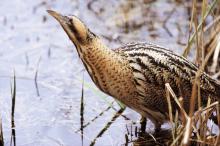UK quarries are providing a safe haven for rare bitterns to nest and breed, helping them to make a resounding comeback in the country.
Making use of the bird’s distinctive ‘booming’ call, conservationists have found that 2011 has proved to be a bumper year for this species, which was once extinct in the UK.
For the first time since 1911, over 100 birds have been found to be nesting in 26 sites throughout England, 15 of them at working or former quarries. This represents a vast improvement on the overall count of just 11 birds recorded in 1996, and the minerals industry has had an important role to play in ensuring this success.
Darren Moorcroft, head of species and habitats conservation at the RSPB
“But we are losing it at an alarming rate. The mineral products industry is uniquely positioned to step up and help turn this around.
“It is fantastic new that all the effort that has been put in to restoring quarry sites around the country has provided a home for this rare and unique bird. Catching a glimpse of a bittern as it takes off from a reed bed, and hearing its amazing booming call are the real rewards for this vital work.”
As a critical part of the UK’s manufacturing base, we are not only essential to construction, to the economy and to growth but are also uniquely placed to make a nationally significant contribution to halting the decline in the UK’s biodiversity.
“Our members already manage or control an area of land that adds up in size to a small national park. Given the right recognition and support, we can achieve a great deal more yet.”
In 2006, research conducted by Nature After Minerals concluded that nine out of the 11 priority wildlife habitats listed in the [UK] government’s former UK Biodiversity Action Plan could be delivered on minerals sites alone.
At its site at Needingworth Quarry in the Fenlands of County Cambridgeshire,
The creation of vital reedbed at this site will help secure the future of breeding bitterns but also that of marsh harriers, snipe, reed buntings, bearded tits, sedge and grasshopper warblers. Water voles, otters, a whole range of plants and insects, and the threatened Desmoulin’s Whorl snail will also stand a better chance of thriving, as a result of the restoration. Such work on minerals sites is being replicated across England by operators large and small.
The minerals industry has long placed great store in the effective restoration of its sites, as the 40-year history of the MPA’s Restoration Awards Scheme will testify.
In October, the MPA and Natural England launched their inaugural Biodiversity Awards in London.
Hanson UK was the runner-up, for its work at the Kings Dyke Nature Reserve in the town of Peterborough, where bitterns were heard booming for the second summer in a row and young were sighted for the first time this year.











